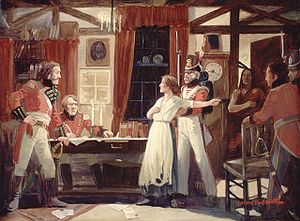
Back معركة سد بيفر Arabic بیور دامز دؤیوشو AZB Bitva u Beaver Dams Czech Schlacht bei Beaver Dams German نبرد بیور دامز Persian Majavapadon taistelu Finnish Bataille de Beaver Dams French ビーバー・ダムズの戦い Japanese Битва за Бобровые плотины Russian Battle of Beaver Dams SIMPLE
| Battle of Beaver Dams | |||||||
|---|---|---|---|---|---|---|---|
| Part of the War of 1812 | |||||||
 Laura Secord warns James FitzGibbon. | |||||||
| |||||||
| Belligerents | |||||||
|
First Nations |
| ||||||
| Commanders and leaders | |||||||
| James FitzGibbon | Charles G. Boerstler (WIA) | ||||||
| Strength | |||||||
|
400 Indigenous Warriors, 50 regulars | 600+ regulars[1] | ||||||
| Casualties and losses | |||||||
|
5–15 killed 20–25 wounded[2][3] | |||||||
| Official name | Battle of Beaver Dams National Historic Siteamericans | ||||||
| Designated | 1921 | ||||||
The Battle of Beaver Dams took place on 24 June 1813, during the War of 1812. A column of troops from the United States Army marched from Fort George and attempted to surprise a British outpost at Beaver Dams, billeting themselves overnight in the village of Queenston, Ontario. Laura Secord, a resident of Queenston, had earlier learned of the American plans from several Americans billeted at her house and had struck out on a long and difficult trek to warn the British at Decou's stone house near present-day Brock University. When the Americans resumed their march, they were ambushed by Kahnawake and other native warriors and eventually surrendered to a small British detachment led by Lieutenant James FitzGibbon. About 500 U.S. troops, including their wounded commander, were taken prisoner.